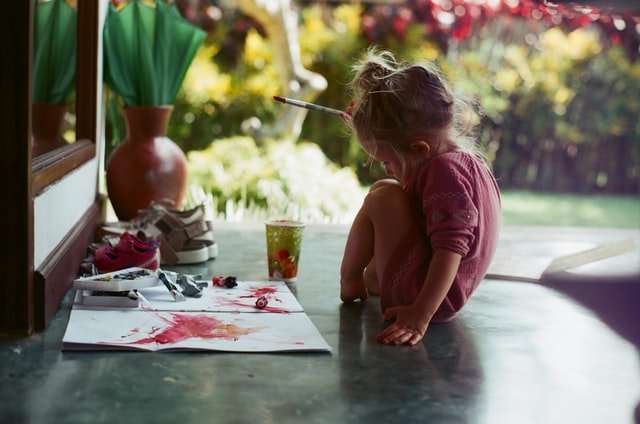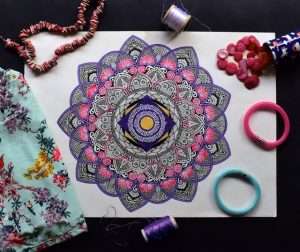Are you looking for advice on how to paint creatively? Are you a beginner painter and want to know the basics of painting? You have just landed on the right page. This article will provide tips and tricks on painting your canvas in a creative way.
How To Paint Creatively – Tips And Tricks
If you are a beginner painter, it is best to use acrylics or watercolors rather than oil paints because they dry faster. When applying paint, do not use too much pressure as this can cause streaks in your canvas. Make sure that your brush is clean and soft. Also, experiment with different brushes. Soft brushes work well for blending while hard brushes create sharper lines. After you have chosen the paint that you desire, use a palette knife to apply it so that there are no brush strokes visible on your canvas.
You may also like these articles:
Blue Flower Painting Ideas
Green Flower Painting Ideas
Pink Flower Painting Ideas
Black Flower Painting Ideas
Yellow Flower Painting Ideas
Orange Flower Painting Ideas
Red Flower Painting Ideas
Purple Flower Painting Ideas
White Flower Painting Ideas
Just think of all the things that can go wrong when you are painting. Things like spillage, uneven brush stroke and dirty brushes that can ruin everything. These tips will help you to overcome all such problems and help you to paint your canvas in a creative way.
TIP 1: Be sure of your canvas size – You should be sure of the size of your canvas before you start out with your painting session. It is very important because if it does not match with the size of your room or wall then it will look awkward and clumsy. Make sure that the size is right and also remember to keep a margin around it so that it doesn’t look crowded on the wall or room.
TIP 2: Use soft brushes – Using soft brushes while painting is always better as they do not leave any hard edges on the canvas. Always use soft brushes for blending effects on the canvas, especially if you are using oil paints.
TIP 3: Do not rush in painting – Rushing in painting may cause lot of mistakes in your painting which might spoil your entire canvas and make it look bad. So always take your time to think about what you want to do next and then proceed further with care.
It’s best to begin with a sketch of what you want to paint. If you’re using acrylics, use pencil or charcoal for the sketch and then overlay it with the acrylic paint. Be sure to let each layer dry before you add another.
…If you’re using oil paints, you can work more quickly because they are thicker and dry slower. After you’ve finished your sketch, apply thin layers of paint directly to your canvas in the same design as your sketch. You can even apply color straight from the tube, although some artists prefer to dilute the paint with turpentine or mineral spirits before applying it.
If you’re working on canvas board, use a medium-sized bristle brush or an artist’s brush…
…Ink is just as versatile as watercolors when it comes to painting flowers on canvas. Ink works especially well for pieces that have a lot of texture…
…Whatever the occasion, you can find suitable artwork for framing at art supply stores. It’s always better to buy original art rather than prints because you can have them custom framed by an expert framer who will make sure they are framed properly..”*
The creation of a painting is an incredible journey for the artist. The act of art comes from somewhere deep inside the artist’s soul, and no matter how it may seem to be, the creation of a painting is a very private process.
It is purposeful and meticulous – full of meaning, intent and vision. As a result, every aspect of the painting – from the composition to the choice of colours – is deliberate.
It can take as little as five minutes or as long as a lifetime for an artist to create his work. It depends on what you want to say with your art and how you want to say it.
So where do you begin? And how do you decide which colours to use? What should you do if you are unhappy with your work? How much time should you spend on each painting? These are all good questions, and ones that I will answer in detail here in this blog.**
Creativity is an essential element of the art studio. Using your imagination is a necessary skill for the artist, whether you are creating paintings, sculptures or jewelry. Creative thinking requires that you have an open mind and you be in tune with your surroundings.
Trial and error are part of the learning process. You may not be successful with your first few attempts at creating a piece of art. By trying new techniques and attempting to be more creative, you will learn about yourself and how to find your niche in the art world. Learning to think creatively can take time, but there are ways to help speed up the process.
New ways of seeing things can be gained by observing nature. Nature contains a wealth of information that can help spark new ideas for your artistic projects. Consider looking at leaves and trees from different angles, or look at flowers from underneath to see how they communicate with each other through color and scent. A walk outside can also lead to inspiration for your next painting or sculpture.
When you have an idea, write it down as soon as possible so you don’t forget it later on in the day. If you are going on vacation, bring a notebook with you so you can jot down any new thoughts or ideas that come to mind during your trip.
The real skill needed to be a good artist is not an ability to draw, but an ability to organize. The better you can organize what you want to draw, the easier it will be to draw.
Here are some tips on how to organize your painting:
1. Use a grid
This is the most important tip, because it’s the one that will save you from wasting time and not getting exactly what you want on your canvas.
2. Use tracing paper
Tracing paper is a big time saver. It allows you to make a perfect copy of an image without having to redraw it yourself by hand.
3. Use templates for objects that recur in your paintings
This includes objects like windows, doors, flowers, cars and so on. Find templates for them online and use them for your paintings instead of drawing everything from scratch every time. You’ll save time this way and also ensure that your painting looks more consistent from one painting to the next.
4. Start with the background first
It’s easier to fill in large areas first while they’re still fresh in your mind and then add detail later once the rest of your painting is finished. This way, if you need to change anything about the background later on, you can
The art world has always been a big deal. All the famous artists in history have been famous for one thing: their masterpieces. But did you know that, at one point in time, there was a series of masterpieces that were created by mistake, but still considered valuable by collectors?
It all started when some art students decided to mess around with their materials and accidentally created a masterpiece! From then on, all students began experimenting with different kinds of paint and ended up creating several other masterpieces as well. The owners of the gallery sold these works for a lot of money, and people flocked to buy them. Some artists even painted over their original masterpieces to create more “accidents.”
Tired of all this weirdness going on, the art world decided to strike back and make sure no more accidental masterpieces were created. They wrote down new rules to prevent this from happening again. Included in these rules was making sure no one got close enough to the paintings or sculptures to actually touch them with their bare hands because that could cause accidents.
This is just one example of how the accidental masterpiece was born, and how it was destroyed by the “experts” in the art world. Now you must be wondering: how do I go about creating


